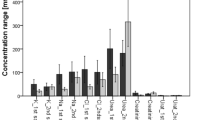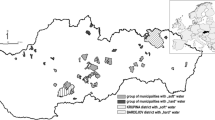Abstract
One hundred patients with ischemic heart disease and 70 healthy subjects were on unified regimen. Urine was collected with 4-h proportions during 3–5 days (72–120 h). Each portion of urine was analyzed for macro- (Na, K, P, Cl, Ca, Mg) and microelements (Fe, Cu, Zn, Cr, Cd, V). Temporal structure (biological and hydrometeorological indices) parameters have been estimated by nonlinear least squares method for sinusoidal rhythms and dispersion analysis for nonsinusoidal rhythms. Data of weather indices were received from the hydrometeorological service of the Republic of Armenia in 2015 at 3-h intervals. Statistically significant rhythms were observed in healthy subjects in 91% cases of 593 rhythmological investigations of water-mineral homeostasis. Acrophases of water-mineral homeostasis mostly had individual nature. Healthy subjects’ rhythms of water-mineral excretion were depending on rhythms of hydrometeorological indices and were characterized with significant correlative connections. Acrophases of indices of water-mineral homeostasis mostly were outstripping the acrophases of the rhythms of hydrometeorological indices. Chronostructure of water-mineral homeostasis in patients with ischemic heart disease was characterized with infradian and circadian fluctuations. In case of individuals with ischemic heart disease, statistically significant correlative connections between rhythms of water-mineral excretion and rhythms of hydrometeorological indices differ in comparison with the results of practically healthy individuals. In patients with ischemic heart disease, acrophases of biorhythms often were concurrent or delayed relative to the acrophases of the rhythms of hydrometeorological indices.

Similar content being viewed by others
Notes
The difference between the saturated and the actual elasticity of water vapor at a given temperature and pressure in the air
The time when studied index reaches to its maximum value in one cycle
The average level of the studied index in one cycle
References
Asatryan LG, Chibisov SM, Babayan LA, Gulyan AK (2019) Temporal structure of electrolytes and trace elements homeostasis in stress and ischemic heart disease. Trace Elem Med Moscow 20(1):21–26 (in Russian)
Aslanian NL, Shukian BM, Krishchian EM, Babayan LA (1984) Application of dispersion analyses for revealing of dian curves repetition of urine, sodium and potassium excretion. Laboratornoe delo, Moscow 1:49–50 (in Russian)
Astabatsyan MA, Babayan LA, Gulyan AK, Sarafyan PK (2018) Chronostructure of water-mineral homeostasis in IHD. Trace Elem Med Moscow 19(1):35–42 (in Russian)
Babayan LA, Chibisov SM, Gulyan AK et al (2019) Temporal organization of electrolytes and trace elements homeostasis in cardiovascular pathology and in immobilization stress. Insights Biomed 4(4):14
Carandente F (1984) From the glossary of chronobiology. Chronobiologia 11:313–318
Gulyan AK, Babayan LA, Arutyunayn Ts G et al (2020) The influence of rhythms of hydrometeorological indices on the water-mineral homeostasis in hypertensive disase. Trace Elem Med Moscow 21(1):22–26 (in Russian)
Gumarova L, Halberg F, Cornelissen G (2014) Effects of examination on the circadian structure of ECG parameters. World Health J 6(1):13–20
Halberg F, Carandente F, Cornelissen G, Katinas GS (1977) Glossary of chronobiology. Cronobiologia 1:1–191
Kanabrocki EL, Scheving LE, Olwin JH et al (1983) Circadian variation in the urinary excretion of electrolytes and trace elements in men. Am J Anat 166:121–148
Komarov FI, Rapoport SI, Breus TK, Chibisov SM (2018) Desynchronization of biological rhythms in response to the impact of environmental factors. Chronobiology Chronomedicine: Moscow: 80–106 (in Russian)
Krishchian EM (1985) Application of approximation methods for sinusoidal rhythms revealing. Chronobiol Chronomed 1:36–37 (in Russian)
Lugovaya EA, Stepanova EM, Gorbachev AL (2015) Approaches to the body elements status assessment. Trace elements in medicine. Moscow 16(2):10–17 (in Russian)
Ozheredov VA, Chibisov SM, Blagonravov MI et al (2017) Influence of geomagnetic activity and earth weather changes on heart rate and blood pressure in young and healthy population. Int J Biometeorol 61(5):921–929
Sing RB, Hristova K, Fedacko J, El-Kilany G, Cornelissen G (2018) Chronic heart failure: a disease of the brain. Heart Fail Rev 24:301–307. https://doi.org/10.1007/s10741-018-9747-3
Skalny AA (2020) Physical activity and trace elements metabolism. Trace Elem Med Moscow 21(2):3–12 (in Russian)
Smolensky MH, Hermida RC, Portaluppi F (2007) Comparison of the efficacy of morning versus evening administration of Olmesartan in uncomplicated essential hypertension. Chronobiol Int 24:171–181
Wanliss J, Cornelissen G, Halberg F, Browr D (2018) Superposed epoch analysis of physiological fluctuations: possible space weather connections. Int J Biometeorol 62(3):449–457
Watanabe Y, Otsuka K, Siegelova J, Cornelissen G (2014) Decadal change in heart rate variability. Noninvasive methods of cardiology. Masaryk University, Brno, Czech Republic, pp 5–9
Wei Z, Liang X, Wan C et al (2013) Patterns of mortality from cardiac cerebral vascular disease and influence from the cosmos. Biol Rhythm Res 45(4):570–589
Wilson DW, Cornelissen G, Lee GC et al (2016) The analysis and presentation of chronobiological data. World Health J 8(4):392
Author information
Authors and Affiliations
Corresponding author
Rights and permissions
About this article
Cite this article
Babayan, L.A., Hayrapetyan, H.A., Gulyan, A.K. et al. Influence of hydrometeorological indices on electrolytes and trace elements homeostasis in patients with ischemic heart disease. Int J Biometeorol 64, 2171–2176 (2020). https://doi.org/10.1007/s00484-020-02009-5
Received:
Revised:
Accepted:
Published:
Issue Date:
DOI: https://doi.org/10.1007/s00484-020-02009-5




